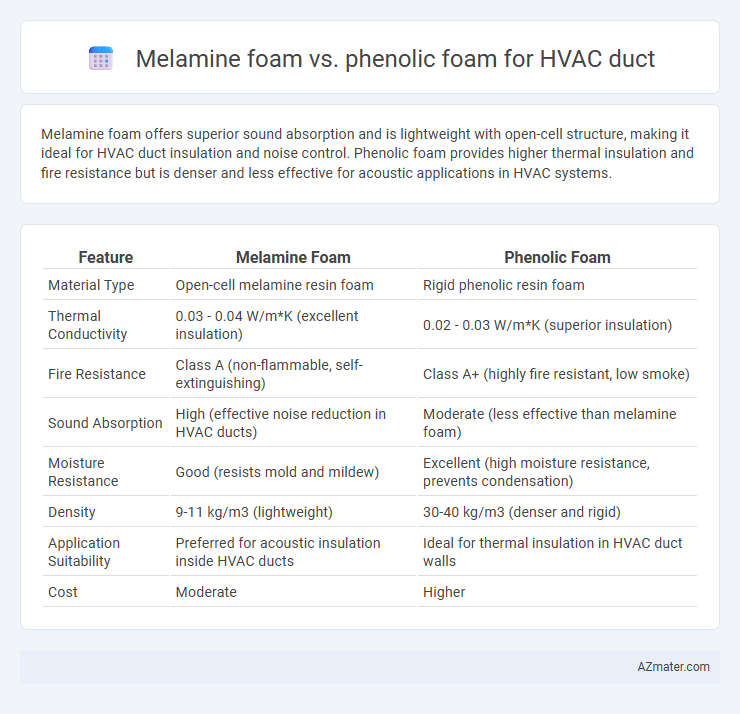Melamine foam offers superior sound absorption and is lightweight with open-cell structure, making it ideal for HVAC duct insulation and noise control. Phenolic foam provides higher thermal insulation and fire resistance but is denser and less effective for acoustic applications in HVAC systems.
Table of Comparison
| Feature | Melamine Foam | Phenolic Foam |
|---|---|---|
| Material Type | Open-cell melamine resin foam | Rigid phenolic resin foam |
| Thermal Conductivity | 0.03 - 0.04 W/m*K (excellent insulation) | 0.02 - 0.03 W/m*K (superior insulation) |
| Fire Resistance | Class A (non-flammable, self-extinguishing) | Class A+ (highly fire resistant, low smoke) |
| Sound Absorption | High (effective noise reduction in HVAC ducts) | Moderate (less effective than melamine foam) |
| Moisture Resistance | Good (resists mold and mildew) | Excellent (high moisture resistance, prevents condensation) |
| Density | 9-11 kg/m3 (lightweight) | 30-40 kg/m3 (denser and rigid) |
| Application Suitability | Preferred for acoustic insulation inside HVAC ducts | Ideal for thermal insulation in HVAC duct walls |
| Cost | Moderate | Higher |
Introduction to Melamine and Phenolic Foam
Melamine foam is a lightweight, open-cell material known for its excellent sound absorption and thermal insulation properties, making it ideal for HVAC duct applications that require noise reduction and moderate fire resistance. Phenolic foam, on the other hand, is a closed-cell, rigid insulation with superior fire resistance, low smoke emission, and high thermal stability, often used in HVAC systems where stringent fire safety standards are crucial. Both materials provide effective insulation, but phenolic foam excels in high-temperature environments, while melamine foam offers enhanced acoustic performance.
Key Properties of Melamine Foam
Melamine foam offers excellent sound absorption, high thermal insulation, and superior fire resistance, making it ideal for HVAC duct applications where noise reduction and safety are critical. Its open-cell structure provides effective airflow and moisture resistance, reducing the risk of mold growth within ducts. Compared to phenolic foam, melamine foam is lighter and more flexible, allowing for easier installation and better accommodation of complex duct shapes.
Key Properties of Phenolic Foam
Phenolic foam for HVAC ducts offers superior fire resistance with a low flame spread index and minimal smoke development, making it ideal for safety-critical applications. Its low thermal conductivity and excellent dimensional stability ensure effective insulation and long-term performance under varying temperature conditions. Compared to melamine foam, phenolic foam provides higher compressive strength and enhanced moisture resistance, contributing to durability and energy efficiency in HVAC systems.
Thermal Insulation Performance Comparison
Melamine foam offers superior thermal insulation performance in HVAC ducts due to its low thermal conductivity of approximately 0.035 W/m*K, which enhances energy efficiency by minimizing heat transfer. Phenolic foam, with a thermal conductivity around 0.021-0.028 W/m*K, provides better insulation than traditional materials but generally exhibits slightly higher density and brittleness, affecting installation flexibility. Both foams contribute to reducing heat loss and improving temperature control in HVAC systems, though phenolic foam tends to excel in thermal resistance and fire retardancy.
Fire Resistance and Safety Standards
Melamine foam offers superior fire resistance for HVAC ducts, meeting stringent UL 94 HF-1 and FMVSS 302 fire safety standards due to its inherent flame retardant properties. Phenolic foam also provides effective flame retardancy with low smoke emission, complying with ASTM E84 Class A and NFPA 285 standards, making it suitable for building codes requiring high fire safety. Both materials enhance HVAC system safety, but melamine foam is preferred where low flame spread and smoke toxicity are critical factors.
Acoustic Performance in HVAC Systems
Melamine foam offers superior acoustic absorption in HVAC systems due to its open-cell structure, effectively reducing noise and vibration compared to phenolic foam. Phenolic foam, while providing excellent thermal insulation and fire resistance, typically shows lower sound absorption coefficients, making melamine foam the preferred choice for enhanced acoustic performance. HVAC designers prioritize melamine foam for noise reduction in duct linings where sound attenuation is critical.
Installation and Handling Differences
Melamine foam offers superior flexibility and lightweight properties, making it easier to cut and install around complex HVAC duct shapes, while phenolic foam is more rigid and dense, requiring specialized tools and careful handling to avoid damage. Melamine's open-cell structure facilitates better conformity to irregular surfaces, improving installation efficiency, whereas phenolic foam's closed-cell design demands precision to maintain its structural integrity. Handling melamine foam reduces labor time and material waste due to its ease of manipulation, contrasting with phenolic foam which often involves longer installation times and higher risk of breakage.
Cost Analysis: Melamine vs Phenolic Foam
Melamine foam typically presents a higher initial cost compared to phenolic foam but offers superior sound absorption and fire resistance properties, which may reduce long-term maintenance and safety expenses in HVAC duct applications. Phenolic foam, on the other hand, provides a more cost-effective solution with competitive thermal insulation performance and lower raw material costs, making it a preferred choice for budget-sensitive projects. Evaluating total lifecycle costs, including installation, durability, and energy savings, is essential for determining the most economical option between melamine and phenolic foam in HVAC systems.
Environmental Impact and Sustainability
Melamine foam exhibits superior environmental benefits compared to phenolic foam due to its lower toxicity and greater recyclability, reducing landfill waste and hazardous emissions. Phenolic foam, while effective for insulation, often involves phenol-formaldehyde resins that pose higher environmental risks during production and disposal. Sustainable HVAC duct solutions increasingly favor melamine foam for its eco-friendly lifecycle and compliance with stringent environmental regulations.
Choosing the Right Foam for HVAC Duct Applications
Melamine foam offers superior sound absorption and fire resistance, making it ideal for HVAC ducts requiring enhanced acoustic performance and safety. Phenolic foam provides excellent thermal insulation and low smoke emissions, suitable for energy-efficient duct systems in commercial buildings. Selecting the right foam depends on balancing factors such as fire retardancy, thermal conductivity (Melamine ~0.035 W/m*K, Phenolic ~0.020-0.025 W/m*K), and acoustic requirements specific to HVAC duct applications.

Infographic: Melamine foam vs Phenolic foam for HVAC duct
 azmater.com
azmater.com